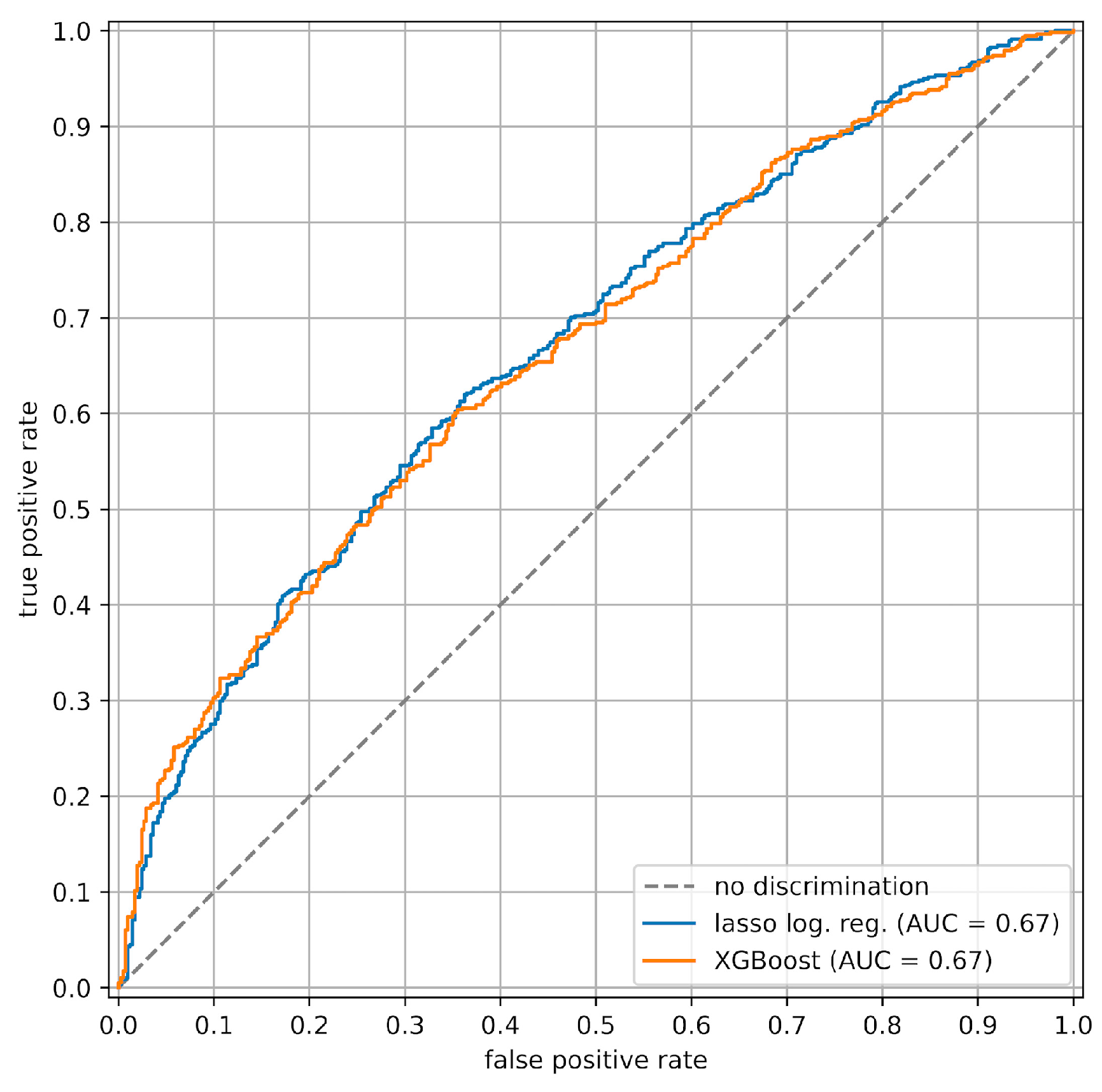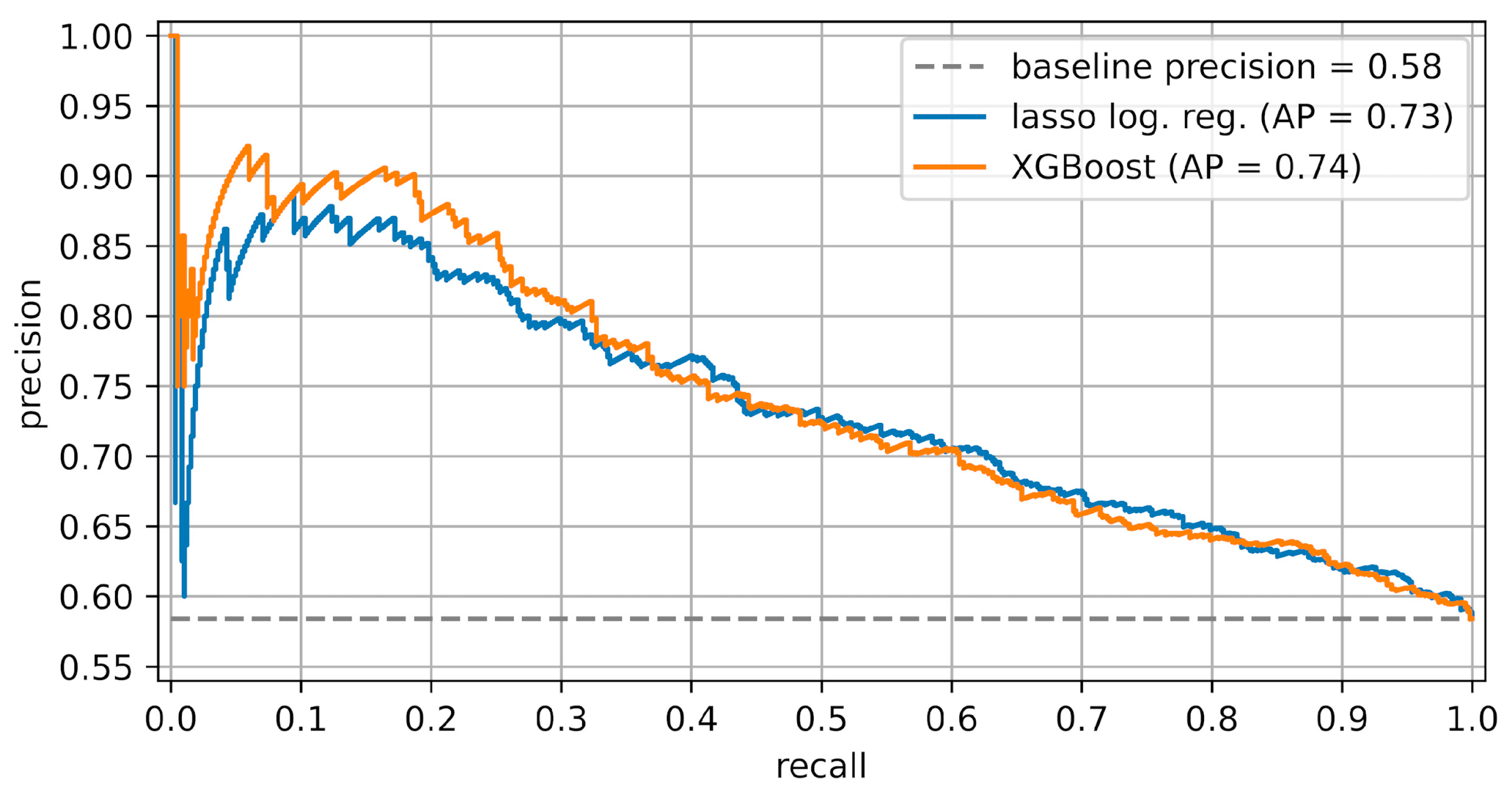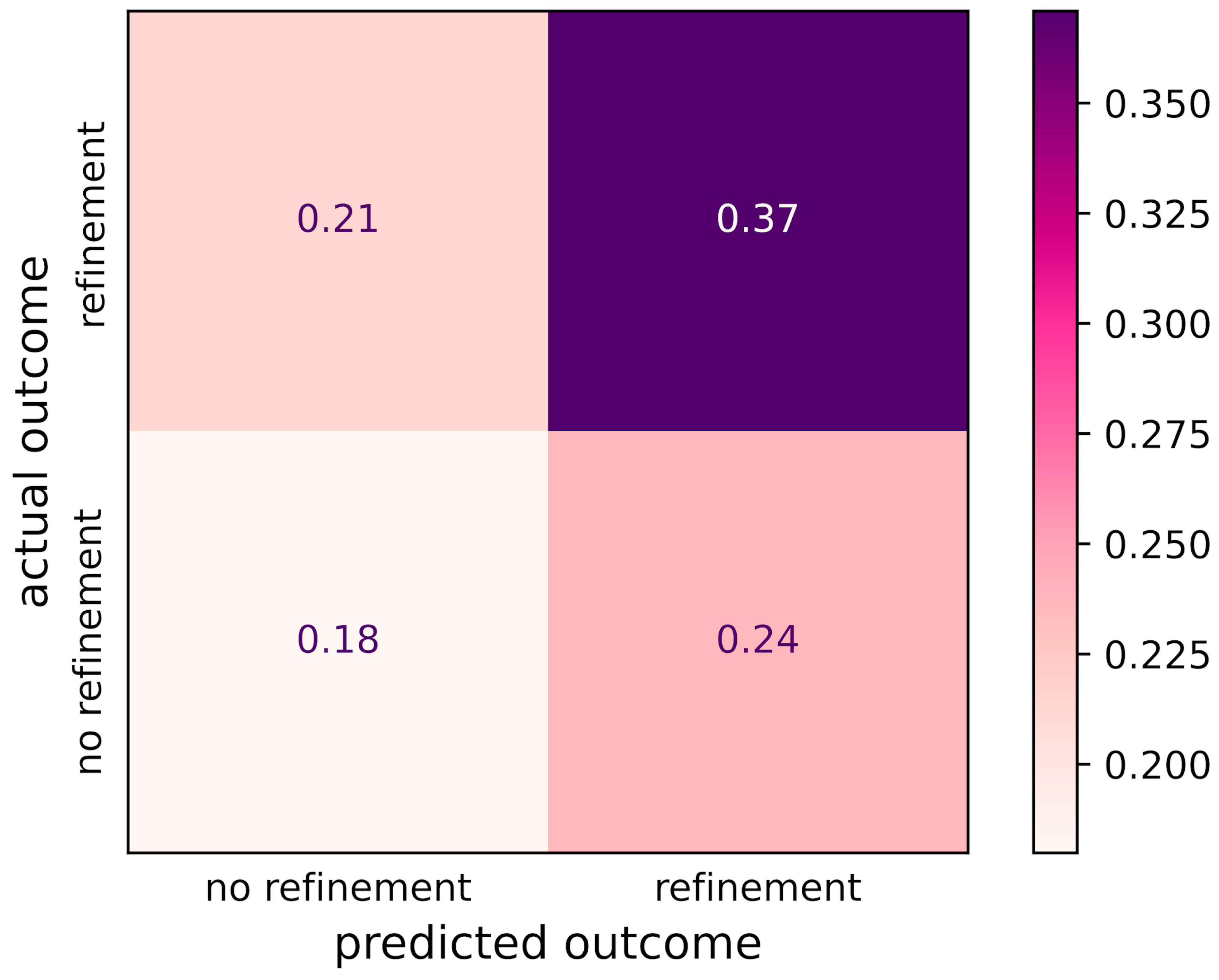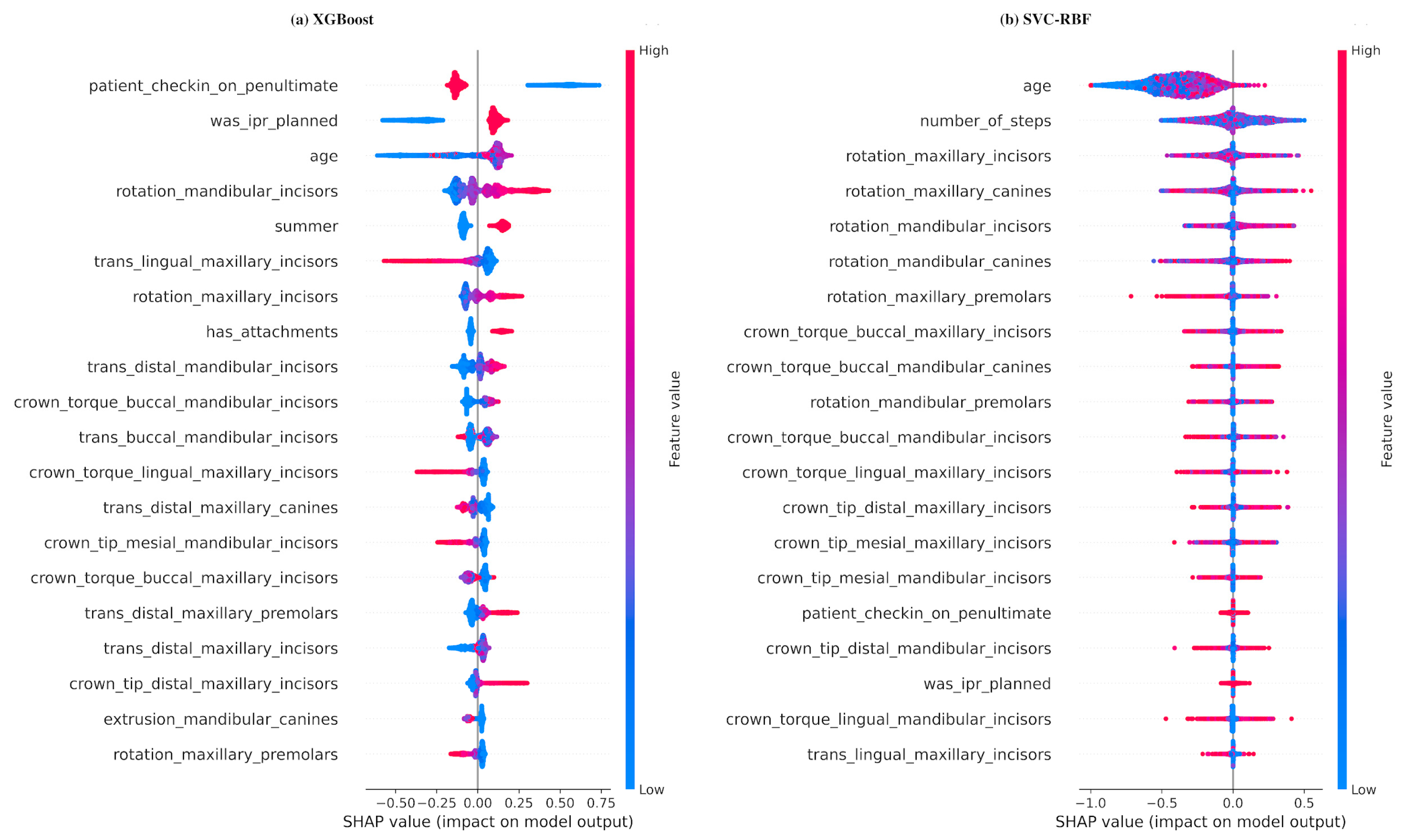Predicting Outcome in Clear Aligner Treatment: A Machine Learning Analysis
Abstract
1. Introduction
2. Materials and Methods
2.1. Study Design
2.2. Setting, Participants, and Sample Size
2.3. Variables
2.4. Bias
3. Results
3.1. Descriptive Statistics
3.2. Performance of the Models
3.3. Interpretation of the Models
4. Discussion
5. Conclusions
Supplementary Materials
Author Contributions
Funding
Institutional Review Board Statement
Informed Consent Statement
Data Availability Statement
Acknowledgments
Conflicts of Interest
References
- Weir, T. Clear Aligners in Orthodontic Treatment. Aust. Dent. J. 2017, 62, 58–62. [Google Scholar] [CrossRef] [PubMed]
- Putrino, A.; Barbato, E.; Galluccio, G. Clear Aligners: Between Evolution and Efficiency—A Scoping Review. Int. J. Environ. Res. Public Health 2021, 18, 2870. [Google Scholar] [CrossRef] [PubMed]
- Favero, L.; Pavan, L.; Arreghini, A. Communication through Telemedicine: Home Teleassistance in Orthodontics. Eur. J. Paediatr. Dent. 2009, 10, 163–167. [Google Scholar] [PubMed]
- Maspero, C.; Abate, A.; Cavagnetto, D.; El Morsi, M.; Fama, A.; Farronato, M. Available Technologies, Applications and Benefits of Teleorthodontics. A Literature Review and Possible Applications during the COVID-19 Pandemic. J. Clin. Med. 2020, 9, 1891. [Google Scholar] [CrossRef] [PubMed]
- Timm, L.H.; Farrag, G.; Baxmann, M.; Schwendicke, F. Factors Influencing Patient Compliance during Clear Aligner Therapy: A Retrospective Cohort Study. J. Clin. Med. 2021, 10, 3103. [Google Scholar] [CrossRef] [PubMed]
- Torsello, F.; D’Amico, G.; Staderini, E.; Marigo, L.; Cordaro, M.; Castagnola, R. Factors Influencing Appliance Wearing Time during Orthodontic Treatments: A Literature Review. Appl. Sci. 2022, 12, 7807. [Google Scholar] [CrossRef]
- Meyer-Bäumer, A.; Pritsch, M.; Cosgarea, R.; El Sayed, N.; Kim, T.-S.; Eickholz, P.; Pretzl, B. Prognostic Value of the Periodontal Risk Assessment in Patients with Aggressive Periodontitis. J. Clin. Periodontol. 2012, 39, 651–658. [Google Scholar] [CrossRef] [PubMed]
- Mullins, J.M.; Even, J.B.; White, J.M. Periodontal Management by Risk Assessment: A Pragmatic Approach. J. Evid. Based Dent. Pract. 2016, 16, 91–98. [Google Scholar] [CrossRef] [PubMed]
- Leavitt, L.; Volovic, J.; Steinhauer, L.; Mason, T.; Eckert, G.; Dean, J.A.; Dundar, M.M.; Turkkahraman, H. Can We Predict Orthodontic Extraction Patterns by Using Machine Learning? Orthod. Craniofac. Res. 2023, 26, 552–559. [Google Scholar] [CrossRef]
- Qu, X.; Zhang, C.; Houser, S.H.; Zhang, J.; Zou, J.; Zhang, W.; Zhang, Q. Prediction Model for Early Childhood Caries Risk Based on Behavioral Determinants Using a Machine Learning Algorithm. Comput. Methods Programs Biomed. 2022, 227, 107221. [Google Scholar] [CrossRef]
- Etemad, L.; Wu, T.; Heiner, P.; Liu, J.; Lee, S.; Chao, W.; Zaytoun, M.L.; Guez, C.; Lin, F.; Jackson, C.B.; et al. Machine Learning from Clinical Data Sets of a Contemporary Decision for Orthodontic Tooth Extraction. Orthod. Craniofac. Res. 2021, 24, 193–200. [Google Scholar] [CrossRef] [PubMed]
- Lucchese, A.; Bertacci, A.; Chersoni, S.; Portelli, M. Primary Enamel Permeability: A SEM Evaluation In Vivo. Eur. J. Paediatr. Dent. 2012, 13, 231–235. [Google Scholar]
- Couronné, R.; Probst, P.; Boulesteix, A.-L. Random Forest versus Logistic Regression: A Large-Scale Benchmark Experiment. BMC Bioinform. 2018, 19, 270. [Google Scholar] [CrossRef] [PubMed]
- Krasowski, A.; Krois, J.; Kuhlmey, A.; Meyer-Lueckel, H.; Schwendicke, F. Predicting Mortality in the Very Old: A Machine Learning Analysis on Claims Data. Sci. Rep. 2022, 12, 17464. [Google Scholar] [CrossRef] [PubMed]
- Meade, M.J.; Ng, E.; Weir, T. Digital Treatment Planning and Clear Aligner Therapy: A Retrospective Cohort Study. J. Orthod. 2023, 50, 361–366. [Google Scholar] [CrossRef] [PubMed]
- Lundberg, S.M.; Erion, G.; Chen, H.; DeGrave, A.; Prutkin, J.M.; Nair, B.; Katz, R.; Himmelfarb, J.; Bansal, N.; Lee, S.-I. From Local Explanations to Global Understanding with Explainable AI for Trees. Nat. Mach. Intell. 2020, 2, 56–67. [Google Scholar] [CrossRef] [PubMed]
- Corbet, E.F. Oral Diagnosis and Treatment Planning: Part 3. Periodontal Disease and Assessment of Risk. Br. Dent. J. 2012, 213, 111–121. [Google Scholar] [CrossRef] [PubMed]
- Dietrich, T.; Ower, P.; Tank, M.; West, N.X.; Walter, C.; Needleman, I.; Hughes, F.J.; Wadia, R.; Milward, M.R.; Hodge, P.J.; et al. Periodontal Diagnosis in the Context of the 2017 Classification System of Periodontal Diseases and Conditions—Implementation in Clinical Practice. Br. Dent. J. 2019, 226, 16–22. [Google Scholar] [CrossRef]
- Ahlers, M.O.; Jakstat, H.A. Evidence-Based Development of a Diagnosis-Dependent Therapy Planning System and Its Implementation in Modern Diagnostic Software. Int. J. Comput. Dent. 2005, 8, 203–219. [Google Scholar]
- Timm, L.H.; Rößler, R.; Baxmann, M. Comparison of Clear Aligner Treatment in First-Treatment and Re-Treatment Patients: A Retrospective Cohort Study. Appl. Sci. 2023, 13, 4303. [Google Scholar] [CrossRef]
- Benchimol, E.I.; Smeeth, L.; Guttmann, A.; Harron, K.; Moher, D.; Petersen, I.; Sørensen, H.T.; von Elm, E.; Langan, S.M. The REporting of Studies Conducted Using Observational Routinely-Collected Health Data (RECORD) Statement. PLoS Med. 2015, 12, e1001885. [Google Scholar] [CrossRef] [PubMed]
- Moons, K.G.M.; Altman, D.G.; Reitsma, J.B.; Ioannidis, J.P.A.; Macaskill, P.; Steyerberg, E.W.; Vickers, A.J.; Ransohoff, D.F.; Collins, G.S. Transparent Reporting of a Multivariable Prediction Model for Individual Prognosis or Diagnosis (TRIPOD): Explanation and Elaboration. Ann. Intern. Med. 2015, 162, W1–W73. [Google Scholar] [CrossRef] [PubMed]
- Chekroud, A.M.; Bondar, I.; Delgadillo, J.; Doherty, G.; Wasil, A.; Fokkema, M.; Cohen, Z.; Belgrave, D.; DeRubeis, R.; Iniesta, R.; et al. The Promise of Machine Learning in Predicting Treatment Outcomes in Psychiatry. World Psychiatry 2021, 20, 154–170. [Google Scholar] [CrossRef] [PubMed]
- Koutsouleris, N.; Kahn, R.S.; Chekroud, A.M.; Leucht, S.; Falkai, P.; Wobrock, T.; Derks, E.M.; Fleischhacker, W.W.; Hasan, A. Multisite Prediction of 4-Week and 52-Week Treatment Outcomes in Patients with First-Episode Psychosis: A Machine Learning Approach. Lancet Psychiatry 2016, 3, 935–946. [Google Scholar] [CrossRef] [PubMed]
- Rossini, G.; Parrini, S.; Castroflorio, T.; Deregibus, A.; Debernardi, C.L. Efficacy of Clear Aligners in Controlling Orthodontic Tooth Movement: A Systematic Review. Angle Orthod. 2015, 85, 881–889. [Google Scholar] [CrossRef] [PubMed]
- Charalampakis, O.; Iliadi, A.; Ueno, H.; Oliver, D.R.; Kim, K.B. Accuracy of Clear Aligners: A Retrospective Study of Patients Who Needed Refinement. Am. J. Orthod. Dentofac. Orthop. 2018, 154, 47–54. [Google Scholar] [CrossRef] [PubMed]
- Lombardo, L.; Arreghini, A.; Ramina, F.; Huanca Ghislanzoni, L.T.; Siciliani, G. Predictability of Orthodontic Movement with Orthodontic Aligners: A Retrospective Study. Prog. Orthod. 2017, 18, 35. [Google Scholar] [CrossRef] [PubMed]
- Bilello, G.; Fazio, M.; Amato, E.; Crivello, L.; Galvano, A.; Currò, G. Accuracy Evaluation of Orthodontic Movements with Aligners: A Prospective Observational Study. Prog. Orthod. 2022, 23, 12. [Google Scholar] [CrossRef]
- Haouili, N.; Kravitz, N.D.; Vaid, N.R.; Ferguson, D.J.; Makki, L. Has Invisalign Improved? A Prospective Follow-Up Study on the Efficacy of Tooth Movement with Invisalign. Am. J. Orthod. Dentofac. Orthop. 2020, 158, 420–425. [Google Scholar] [CrossRef]
- De Felice, M.E.; Nucci, L.; Fiori, A.; Flores-Mir, C.; Perillo, L.; Grassia, V. Accuracy of Interproximal Enamel Reduction during Clear Aligner Treatment. Prog. Orthod. 2020, 21, 28. [Google Scholar] [CrossRef]
- Li, X.; Li, M.; Lu, J.; Hu, Y.; Cui, L.; Zhang, D.; Yang, Y. Age-Related Effects on Osteoclastic Activities after Orthodontic Tooth Movement. Bone Jt. Res. 2016, 5, 492–499. [Google Scholar] [CrossRef] [PubMed]
- Schubert, A.; Jäger, F.; Maltha, J.C.; Bartzela, T.N. Age Effect on Orthodontic Tooth Movement Rate and the Composition of Gingival Crevicular Fluid. J. Orofac. Orthop./Fortschritte Kieferorthopädie 2020, 81, 113–125. [Google Scholar] [CrossRef] [PubMed]
- Chen, H.; Janizek, J.D.; Lundberg, S.; Lee, S.-I. True to the Model or True to the Data? arXiv 2020, arXiv:2006.16234. [Google Scholar]
- Alwosheel, A.; van Cranenburgh, S.; Chorus, C.G. Is Your Dataset Big Enough? Sample Size Requirements When Using Artificial Neural Networks for Discrete Choice Analysis. J. Choice Model. 2018, 28, 167–182. [Google Scholar] [CrossRef]
- Kuhn, M.; Johnson, K. Feature Engineering and Selection; Chapman and Hall/CRC: New York, NY, USA, 2019. [Google Scholar] [CrossRef]
- Van Calster, B.; McLernon, D.J.; van Smeden, M.; Wynants, L.; Steyerberg, E.W. Calibration: The Achilles Heel of Predictive Analytics. BMC Med. 2019, 17, 230. [Google Scholar] [CrossRef]
- Kumar, I.E.; Venkatasubramanian, S.; Scheidegger, C.; Friedler, S. Problems with Shapley-Value-Based Explanations as Feature Importance Measures. In Proceedings of the 37th International Conference on Machine Learning, Virtual Event, 13–18 July 2020. [Google Scholar]
- Chen, T.; Guestrin, C. XGBoost. In Proceedings of the 22nd ACM SIGKDD International Conference on Knowledge Discovery and Data Mining, San Francisco, CA, USA, 13–17 August 2016; ACM: New York, NY, USA, 2016; pp. 785–794. [Google Scholar] [CrossRef]
- Haussler, D.; Boser, B.E.; Guyon, I.M.; Vapnik, V.N. A training algorithm for optimal margin classifiers. In Proceedings of the Fifth Annual Workshop on Computational Learning Theory, Pittsburgh, PA, USA, 27–29 July 1992; pp. 144–152. [Google Scholar] [CrossRef]
- James, G.; Witten, D.; Hastie, T.; Tibshirani, R. Resampling Methods. In An Introduction to Statistical Learning; Springer Texts in Statistic; Springer: New York, NY, USA, 2013; pp. 175–201. [Google Scholar] [CrossRef]
- Tibshirani, R. Regression Shrinkage and Selection Via the Lasso. J. R. Stat. Soc. Ser. B 2018, 58, 267–288. [Google Scholar] [CrossRef]




| Covariate | Scaled Coefficient | Unscaled Coefficient | 95% Confidence Interval of Scaled Coefficient | p Value < Bonferonni Threshold |
|---|---|---|---|---|
| lingual translation of maxillary incisors (mm) | –1.27 | –0.25 | (–1.79, –0.74) | yes |
| rotation of mandibular incisors (°) | 0.97 | 0.03 | (0.62, 1.32) | yes |
| lingual translation of mandibular incisors (mm) | –0.80 | –0.15 | (–1.59, –0.01) | no |
| distal crown tip of maxillary incisors (°) | 0.73 | 0.05 | (0.19, 1.27) | no |
| patient checked in aligners up to and including penultimate check-in (Boolean) | –0.72 | –0.72 | (–0.83, –0.61) | yes |
| rotation of maxillary incisors (°) | 0.67 | 0.02 | (0.32, 1.03) | yes |
| mesial crown tip of mandibular incisors (°) | –0.66 | –0.05 | (–1.27, –0.05) | no |
| was IPR planned (Boolean) | 0.47 | 0.47 | (0.35, 0.58) | yes |
| age between 18 and 24 (Boolean) | –0.37 | –0.37 | (–0.49, –0.26) | yes |
| summer (Boolean) | 0.28 | 0.28 | (0.18, 0.39) | yes |
| has attachments (Boolean) | 0.24 | 0.24 | (0.12, 0.36) | yes |
| male (Boolean) | 0.10 | 0.10 | (0.00, 0.20) | no |
| constant term (logit) | 0.09 | 0.09 | (–0.10, 0.29) | p > 0.05 |
Disclaimer/Publisher’s Note: The statements, opinions and data contained in all publications are solely those of the individual author(s) and contributor(s) and not of MDPI and/or the editor(s). MDPI and/or the editor(s) disclaim responsibility for any injury to people or property resulting from any ideas, methods, instructions or products referred to in the content. |
© 2024 by the authors. Licensee MDPI, Basel, Switzerland. This article is an open access article distributed under the terms and conditions of the Creative Commons Attribution (CC BY) license (https://creativecommons.org/licenses/by/4.0/).
Share and Cite
Wolf, D.; Farrag, G.; Flügge, T.; Timm, L.H. Predicting Outcome in Clear Aligner Treatment: A Machine Learning Analysis. J. Clin. Med. 2024, 13, 3672. https://doi.org/10.3390/jcm13133672
Wolf D, Farrag G, Flügge T, Timm LH. Predicting Outcome in Clear Aligner Treatment: A Machine Learning Analysis. Journal of Clinical Medicine. 2024; 13(13):3672. https://doi.org/10.3390/jcm13133672
Chicago/Turabian StyleWolf, Daniel, Gasser Farrag, Tabea Flügge, and Lan Huong Timm. 2024. "Predicting Outcome in Clear Aligner Treatment: A Machine Learning Analysis" Journal of Clinical Medicine 13, no. 13: 3672. https://doi.org/10.3390/jcm13133672
APA StyleWolf, D., Farrag, G., Flügge, T., & Timm, L. H. (2024). Predicting Outcome in Clear Aligner Treatment: A Machine Learning Analysis. Journal of Clinical Medicine, 13(13), 3672. https://doi.org/10.3390/jcm13133672









